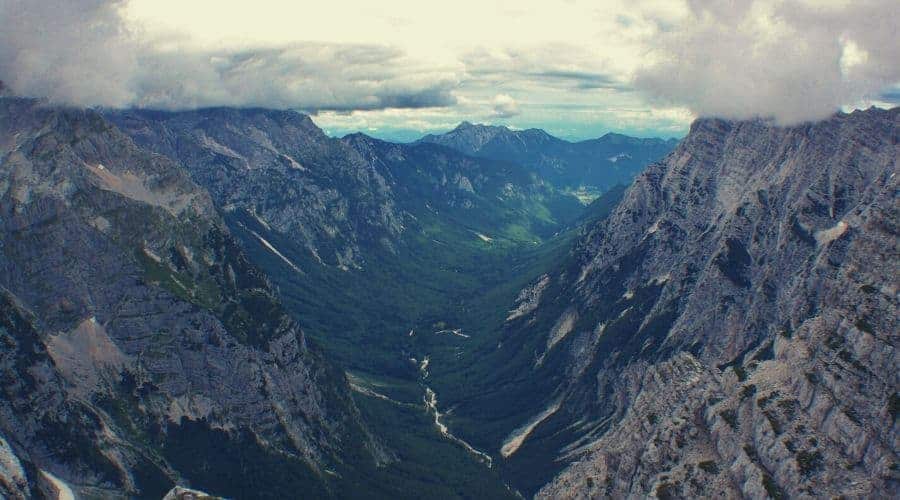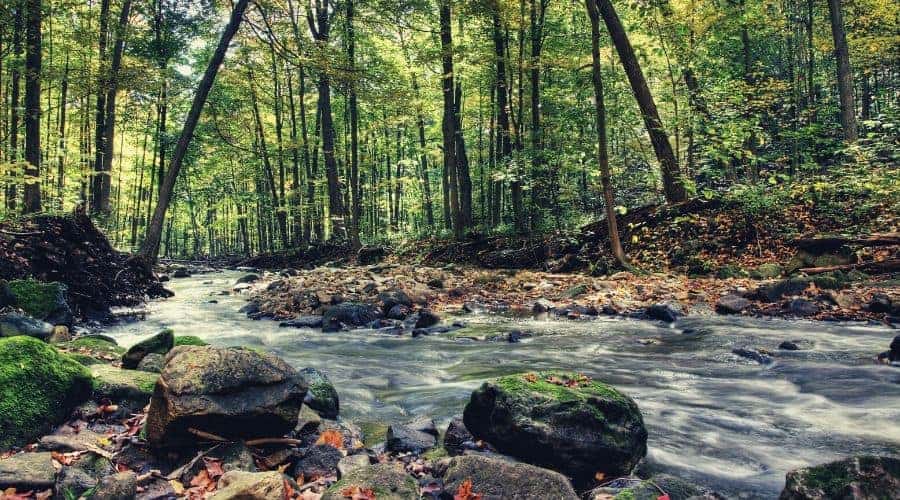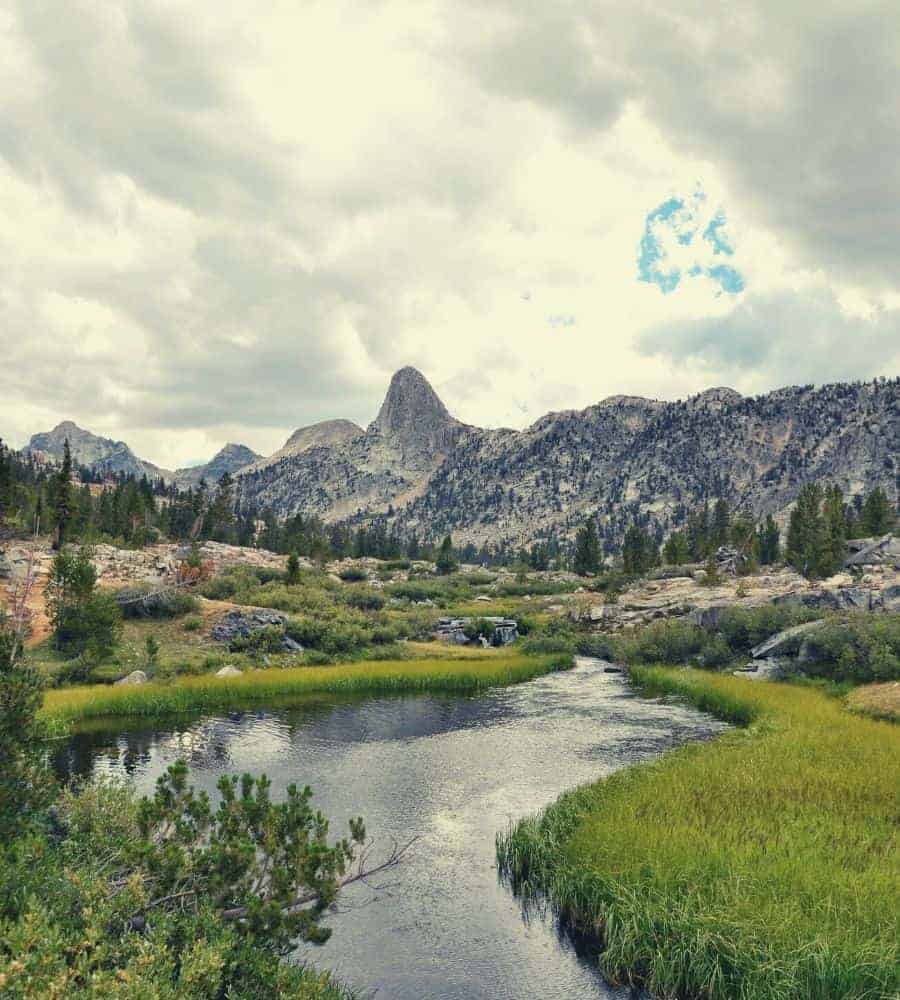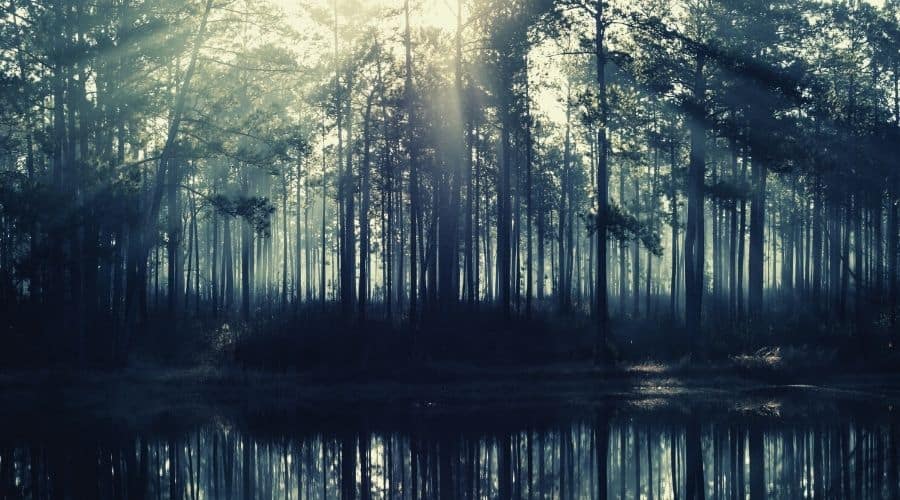Around 2,000 people get lost in the woods every year.
We all believe we’re not going to be one of those unfortunate souls…but none of us can ever be 100% sure. While nothing in life is certain, we can guarantee you’ll reduce your odds of it happening to you if you follow our guide below.
In this article, we’ll explore what to do if you get lost in the woods and don’t have a functioning GPS, hiking watch or compass to bail you out.
We’ll go through the survival strategies you need to know. We’ll also tell you how to avoid getting into this precarious situation in the first place. But before getting into the nitty-gritty, here are a few dos and don’ts every hiker or backpacker should memorize.
Table of Contents
How to Get UNlost
Below, we take you through the main strategies that will help you get from nowehere to somewhere when your hike goes awry.
Use The STOP Method
Once you realize you’re lost, the first things you need to do are stop, relax, and think about your situation carefully. Excessive anxiety will only cloud your judgment and drain your energy. You don’t want to waste any time or energy on projects that don’t have a clear goal.
Luckily for you, safety experts developed the STOP method to help you remember what to do after you realize you’re lost. These letters stand for: “stay calm,” “think,” “observe,” and “plan.”
As you can see, these steps are pretty self-explanatory. For the best chance of survival, it’s imperative that you calm your mind so you can objectively think about your situation.
A few questions you should address are: How did I get here? How long will my food and water last me? Where’s the closest river or stream? Where should I set up shelter? What’s the weather like? How long till it gets dark? How’s my health?
We’ll go through STOP protocol strategies in greater detail in the “How To Survive While You Await Rescue” section. For now, it’s critical to remember that maintaining a positive outlook is your most powerful survival tool. Giving into despair and panic will significantly lessen your chances of making it out of the woods alive.
Pinpoint Your Location
Once your mind is calm, observe your surroundings and try to get an idea of where you’re located. Try and mentally retrace your steps.
If it is safe to do so, then climb to the highest elevation possible to better assess your location. If such a venture will take significant time or energy, or you don’t feel confident in undertaking it, then DO NOT attempt it. Simply STAY PUT.

From this higher vantage point, see if you can make out any signs of civilization – things like a road or buildings, clearings, smoke, pylons, or logging areas. You should also be on the lookout for cairn stones, sources of water, open fields, and potential shelter.
Travel Downhill
Survival experts recommend that people who are lost in mountains or forests travel downhill. In most wildlife areas, it should take you no more than 20 hours of walking downhill to reach a town or city, or at least a road or established trail.
Since most cities in the past were built near bodies of water, it’s likely you’ll come across other humans once you reach the stream’s source by heading in a downhill direction towards a valley. Not only are you more likely to come across civilization by walking downhill, but it’s also easier on your body and will save you energy.

As with climbing to a vantage point, this should only be attempted if you are very confident that you will come across some form of civilization quickly and that it is within your capabilities. If you are unsure, tired, or not confident then the best thing to do is to STAY PUT.
Look (And Listen) For Signs Of Other Humans
Keep your eyes (and ears) peeled for any and all traces of humans. Whether it’s some trash left behind by a non-practitioner of LNT, a trail or pathway, camping sites, or the sounds of people talking.
The Biggest Risks To You If You Get Lost
If you can’t determine your location or navigate your way back to civilization, then you are best to STAY PUT and await rescue. While waiting for help to arrive, you should be aware of the biggest risks that you are likely to face and how to effectively handle them.
Dehydration
You can only survive a few days without water. This timeframe, however, could be even shorter if you’re hiking in humid environments.
On most trips, you’ll likely have brought H2O with you, but packing a water purifier such as the lifestraw could help save your life by allowing you to drink safely from wild water sources. Alternatively, if you have brought a stove or are adept at making fires, then boiling H2O from a stream will also make it safe to drink.
To save time and energy, if possible, set up your shelter by a stream or river. Although you might feel more hunger pains than symptoms of dehydration, you should always prioritize hydration over hunger.
Hypothermia
Sadly, many hikers underestimate how easy it is to die from hypothermia. The onset of hypothermia is usually gradual, so you have to watch yourself carefully before the debilitating symptoms take hold of you.
Officially defined as a drop in body temperature below 95°F, hypothermia produces symptoms such as extreme shivering, weakened pulse, delirium, and poor balance. It’s far easier for you to contract hypothermia at night, especially if you’re in an area that’s damp.
If you feel your temperature dropping, remove any wet clothes you have on because these only increase your risk of developing hypothermia. Use your emergency blanket and light a fire nearby to provide external heat. You can also warm yourself internally by boiling H2O and drinking it slowly.
Heat Exhaustion
For people lost in hot environments, one of the main concerns is going to be heat-related problems like heat stroke. This problem, of course, goes hand-in-hand with dehydration.
Once again, you have to be in tune with your body and notice if you start to experience any sudden muscle cramps. Cramps are an early warning sign that you’re dehydrated. As these symptoms appear, try to find a shaded area and drink purified water.
Once you start to experience symptoms like nausea, clammy hands, of a fast pulse, you must lie down in the shade, sip a drink slowly, and sprinkle cool water all over your face and body.
Finally, to avoid sunburn and eye damage, a container of high-grade sunscreen and a pair of sunglasses are musts if you’re hiking in high temps or areas where you’ll be exposed to the sun.
Hunger
While not as crucial as water, food is important for giving you the energy you need to create and maintain your shelter, or to hike out to safety. Take stock of the food you’ve brought with you and work out how to stretch out your supply for as long as possible.
The best way to reduce your need for food is to reserve your energy only for necessary tasks. With more energy in reserve, you’ll naturally require less food to survive.
As you probably already know, a case of the munchies can seriously impair your thinking. Whenever hunger cravings overwhelm your mind, just slow down, relax, and remember that humans can survive three weeks without food. After a few hours, your mind should become significantly less stressed.
How To Survive While You Await Rescue
Now that you know the greatest risks to your safety, it’s time to learn how to keep yourself going while waiting on help while out in the wild. In this section, we’ll explore some of the best safety equipment and a few tips on how to remain calm, conserve your energy, and call for help.
Always Bring The 10 Essentials
Surviving when you do get lost involves a little preparation. Always, always make sure you have the backpacking 10 essentials with you when you go out hiking or backpacking:
- Water purifier
- Extra food and bottled water
- Firestarter, matches, lighter
- First Aid Kit
- Emergency shelter (e.g. a tarp or bivvy)
- Extra Insulation (emergency blanket or extra clothes)
- Flashlight/Headlamp
- Navigation tools (e.g. compass, personal location beacon, maps)
- Sun Protection
- Repair kit & Tools (duct tape and multi-tool are a great combo)
Stay Calm
The realization that you’re lost can come as a great shock to your psyche. That’s why the STOP protocol gives precedence to remaining calm. Giving yourself a heart attack in the wild certainly won’t help your chances of survival!
You need a cool head now more than ever. If you’ve never practiced meditation before, now is as good a time as any to begin. Sit down and notice your in-breath and out-breath for 15 to 30 minutes. It takes about 30 mins or so for adrenaline to be broken down in your body. Allowing yourself this time to calm down will allow you to think much more clearly again.
Once your mind is calm, you can assess your situation with more objectivity. You’ll also notice that your imagination doesn’t run off to “worst-case scenarios.”
Find Water
If you have made the decision to wait out and be rescued then the first priority is locating a reliable water source nearby without wandering too far off.
If you can’t find a stream or lake, consider hanging out a tarp to collect rainwater. While quite intensive, you can also use a piece of clothing to collect morning dew off plants and trees and wring the H2O out into a suitable container.
Make A Shelter
In order to effectively ward off hypothermia, you need to create a reliable source of fire and find a good shelter. Besides a cave (uninhabited, of course), the best shelter for a cold night in the woods is a tent. If you don’t have a tent and can’t find a safe cave, then try to set up camp near fallen trees or by rock outcroppings.
Anyone who doesn’t have an emergency tent with them can build a makeshift tent out of other materials like a tarp or a poncho. You’ll need to tie a rope or place a branch between two nearby trees before draping your tarp over. For extra support, place heavy rocks on the ground on the tarp’s corners.
Alternatively, with some natural resources such as fallen logs, branches, and ferns you could also build your own bivouac to keep you dry and warm.
Energy Conservation
While it’s important to find and build a shelter, many hikers don’t realize that it’s equally important to rest. Far too many people trapped in the wild unnecessarily burn themselves out.
Don’t walk around aimlessly for hours on end. Always think through your strategy before wasting your energy. You really need to watch how much energy you exert if you don’t have a huge food supply.
When you need a break, then sit back, drink some water, eat something, get in your sleeping bag, and rest. Some hikers find it’s better to take catnaps throughout the day instead of sleeping all through the night. This is especially the case if you have trouble falling asleep in the woods after dusk.
Signal To Rescuers
This may be stating the obvious, but make sure you are ready to signal potential rescuers. This could take many forms, such as blowing a whistle (which I hope you have in your pack), flashing a mirror (or shiny metallic object) or even spelling “help” on the ground in an open area.
If lost in the mountains, you should use the appropriate signals to alert mountain rescue plane or helicopter teams.
How To NOT Get Lost In The Woods
As doctors often say, “an ounce of prevention is worth a pound of cure.” The same principle applies to hikers. While it’s great to know what to do when lost in the woods, it’s far more effective to know how to avoid getting lost than it is to get out of a dire situation. Let’s explore the top strategies every hiker needs to put into place before going on an expedition.
Let Someone at Home Know Where You’re Going
The most important thing before going on a hike is to let friends and family know where you’re going and for how long. Leave them a map of your planned route and any other pertinent information about your trip, i.e. direction of travel, parking location. This way, if you don’t return within the timeframe you’ve provided, then your loved ones can alert the authorities.
Unfortunately, some hikers aren’t humble enough to practice this crucial step. Don’t get caught up in the mythos of the “rugged explorer.” Letting others know your whereabouts is a sign of maturity and it’s critical for your safety.
Travel In Open Areas Or Popular Tourist Destinations
This is a great tip if you’re a beginner. It’s an even better idea to stay close to your home on your first hiking adventure. While it might not be as exciting as heading deep into the wilds, this is a great way to learn basic navigation skills in a safe environment.

Travel With A Guide
If you’re not too experienced with hiking or backpacking, there’s no shame in scheduling a tour with a guide, which is also a great way to learn the ropes before venturing out on your lonesome.
While this tip is optional for easier hiking treks, it’s a requirement for all other times. There are plenty of websites where you can book guided hiking tours around the world, so there’s no excuse for going it alone in areas out of your comfort zone.
OK, we get it. You want to get out there and hike right away. That’s understandable. However, it’s to your benefit to do a bit of bookwork on basic navigation skills before going on hiking expeditions. Particularly, learning how to use a compass with a map, and how to read trail signs.
It’s hard to put a figure on how many hikers get lost each year owing to imperfect navigational skills because most would be too embarrassed to admit it, but we’d estimate the total to be in the region of 99%.
What skills are essential to master? Well, you should know how to read scales on a map. The most common map is 1:25,000, which means one centimeter on the map translates to 250 meters on the ground. You should also be able to identify features on the map and understand contouring, both of which can help you navigate terrain safely.
Also, although we all have compasses on our cell phones nowadays, you should seriously figure out how to use a real compass. Invest in a high-quality compass you feel comfortable with and learn how to use it before your hike.
Using a GPS app or GPS device is fine for the sake of expediency, but you should always carry a map and compass in your backpack as a backup. And because navigating in good weather is far easier than doing so in the foul kind, it’s always wise to check the weather forecast before setting off.
What to Do if you get lost in the woods? Practice These Tips And You’ll Never Lose Your Way
Hopefully, you understand by now the importance of taking precautions. If you take nothing else from this article, please remember to tell all your relations about your trip and carry your essential travel gear with you on the trail. These two preventative tips, along with the strategies listed above, could well prove critical in “surviving to tell the tale.”
So, how did you like our guide on how to find your way out of the woods when the proverbial feces hit the fan? If there’s anything we’ve missed, or if you have any questions, please let us know! And if you’d like to share this post will fellow backcountry wanderers, share away!

